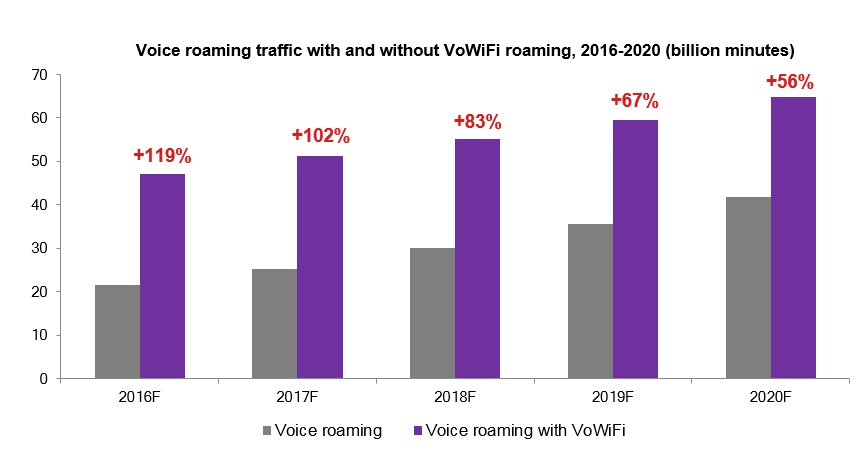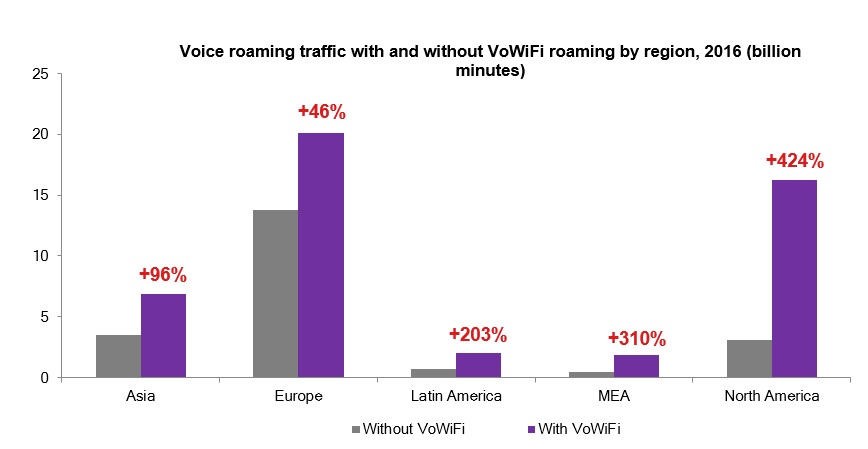The Death of the Silent Roamer
by Isabelle Paradis, President at Hot Telecom
VoWiFi is not a new concept by any stretch of the imagination, but its integration into mobile phones is rapidly increasing in popularity with both end-users and mobile operators alike.
Technological advances around next generation WiFi calling, together with the proliferation of LTE networks and VoLTE services, means that this integrated solution is an ideal weapon to fight back against voice applications such as Skype, WhatsApp and Viber.
Could VoWiFi really be the long awaited instrument that mobile operators have been waiting for to finally win back their customers’ voice roaming traffic from OTT applications and trigger the death of the silent roamers?
Time will tell… but let’s see what impact it would have if it did.
A WIN-WIN FOR CUSTOMERS AND PROVIDERS
In a perfect world, voice calling should be totally seamless for customers, no matter where they are. This means that the voice application should be embedded natively within the phone dialer, should just work regardless of where you are, and should also work on any mobile devices and over any networks. This is everything that mobile operators can enable with VoWiFi and everything that the alternative voice applications are not.
Through VoWiFi, end-users benefit from:
- seamless call transfer between WiFi and cellular (VoLTE, 3G and 2G)
- a single and uniform voice dialer integrated in the smartphone (no need to download a special application or have a separate identity)
- voice over any quality WiFi networks (home, office and hotspots)
- transparent user experience for voice and messaging whether the user is in WiFi or cellular coverage (with single call and messaging logs)
While at the same time, mobile operators benefit from:
- better network coverage (indoor and outdoor)
- a lower cost solution to expand their footprint
- an environment which bypasses the high roaming settlement fees
- offloading of the cellular access network to reduce spectrum needs
So there is still hope yet for mobile operators to win back their customers from other voice applications. Nevertheless, they need to get their act together fast and take the leap to enable VoWiFi capabilities and couple them with innovative pricing models. The success of the first is completely dependent on the other. No matter how simple, painless and efficient VoWiFi calling is, if the pricing is not right, customers will not embrace it.
This becomes even more the case when we extend this concept in a roaming environment. A world where mobile users are able to benefit from seamless VoWiFi/VoLTE while roaming, with all the benefits that it brings (including competitive roaming rates), may finally be a world where the evil word ‘silent roamers’ may become a plague of the past.
PRICING AT THE CENTER OF THE ROAMING WAR
Clearly, the main benefit of the use of VoWiFi in a roaming environment is that it enables mobile operators to by-pass the high roaming settlement fee charged by the visited network operators.
It therefore gives them practically complete control to create competitive roaming packages for their customers. This is key. As stated earlier, unless mobile operators are brave enough to finally charge for roaming at a sensible rate, they can forget about ever winning the operator/OTT roaming race. They can therefore continue to expect between 50% to 75% of their roamers to switch-off their voice roaming capabilities as soon as they touch ground in a foreign country.
But priced correctly, VoWiFi roaming is in my opinion the perfect opportunity for mobile operators to mitigate the voice traffic cannibalization they have suffered from in the last 3-5 years.
So what options do mobile operators have when it comes to setting VoWiFi roaming packages? In theory, mobile operators have 2 pricing options (see table below) to choose from and each comes with benefits, but also with some drawbacks, and using the right one is crucial.
VOWIFI ROAMING – PACKAGE OPTIONS
| Status quo | Roam-like-home | |
|---|---|---|
| Package options | Same rates and packages apply for WiFi roaming as they do now for cellular roaming | WiFi roaming calls are charged at the same rates as a call initiated from the home network |
| Benefits | • Simple to implement • No revenue cannibalization • Increased profitability for WiFi roaming calls | • Simple for users to understand • Stimulates voice roaming traffic • Compete with OTT offering |
| Drawbacks | • Will probably not stimulate roaming traffic • Customers will continue to choose cheaper or free options | • May put pressure on operators’ roaming revenue and margin • For simplicity, this same package should apply for calls initiated on cellular also |
Realistically, if a mobile operators’ objective is to improve customer experience and stimulate usage, while accepting a lower margin on the potentially higher revenue stream, the best pricing option is Roam-like-home. From a roamer’s point of view, this option virtually removes roaming related voice charges and his roaming call usage should, from there on, more closely mirror the usage he would have generated while at home.
It will be key here for operators to extend the Roam-like-home type of packages to all roaming calls, both over WiFi or cellular networks. This will firstly keep this offering as simple as possible for customers to understand and use. Secondly, it should ensure that maximum roaming traffic stimulation and repatriation (from the OTTs) is achieved. Through this offering, mobile operators therefore have the chance to finally give the customers what they have been looking for: sensibly priced, high quality roaming.
THE DREAM HAS BECOME REALITY
Some have decided to grab the VoWiFi roaming opportunity, namely T-Mobile, AT&T and Google (through its Project Fi) in the US. In Europe more recently, Orange Romania has started to offer this option and EE-UK will soon follow by extending its VoWiFi functionality from its national network to the rest of the world in a roaming environment.
So, what type of voice roaming packages have been made available to subscribers so far over WiFi?
For subscribers of a T-Mobile Simple Choice plan, international roaming calls from any Simple Global country to any other country are US$0.20/min (over WiFi or cellular networks). Additionally, subscribers get free Wi-Fi calling within the U.S., Mexico, and Canada, and free Wi-Fi calling from any other country to these three destinations. Wi-Fi calls made from non-Simple Global countries to other countries are charged at T-Mobile’s usual roaming rates.
In the case of Google, their Nexus 6P, 5X and 6 customers have access to transparent VoWiFi and cellular roaming to 120+ countries. After having paid a basic Fi fee of US$20/month, Fi customers benefit from a flat fee of US$0.20/minute while roaming on cellular network. However, this is offered only for destinations supported by Google Fi. For WiFi calling, rates vary by destinations (these are rates used by Google Hangouts) and inbound calls are free.
This is only the tip of the iceberg, and I am convinced that as time goes by and as the number of VoWiFi roaming offerings increase, we will see a number of creative packages that will finally convince roamers to use their native phone applications to make calls when travelling.
THE POTENTIAL IMPACT OF A PERFECT ROAMING WORLD
If we were in a perfect world and if mobile operators across the globe switched to a Roam-like-home type of pricing structure (triggered by the introduction of VoWiFi roaming into the mix), what impact would that have on the roaming traffic worldwide over the next 5 years?
If a Roam-like-home pricing structure was to be implemented across the board for both VoWiFi and cellular network calls, we believe that the roaming voice usage would tend to mirror the home voice usage. In addition, the silent roamer phenomena would disappear, as roamers move away from having to seek out a WiFi connection and then start up their communications App and simply choose to use their native mobile operator’s voice dialer.
Based on these two assumptions, we believe that if this had been implemented at the start of this year, voice roaming traffic would increase by close to 120% in 2016 alone. As shown in the chart below, from an estimated 21.5 billion minutes (if using the status quo pricing structure), traffic would climb to an estimated 47.1 billion minutes.
As we move through time on our way towards 2020 however, the impact of a Roam-like-home package using VoWiFi would slowly decrease, as we believe that regulators around the world are moving towards that roaming pricing structure anyway, as we have seen in Europe more particularly.
Nevertheless, based on our current estimates, we believe that roaming traffic could easily grow by a Compounded Average Growth Rate (CAGR) of 63% over the next 5 years, bringing its total to 64.9 billion minutes in 2020, compared to 41.7 billion minutes if the status quo continues.

If we look at the potential impact on a regional basis, we see that the greatest impact would be felt in North America, where home usage is the highest of all regions on average and where current roaming rates are still very high. Additionally, the time spent away on each roaming trip (on average 11 nights) is the highest of all regions. We therefore estimate that if Roam-like-home pricing was implemented, the roaming traffic generated by North American users would increase by 424% in 2016 (not a small number). The MEA and Latin America follow with a forecasted increase of 310% and 203% respectively.
At the other end of the spectrum, we find Europe, where roaming rates have already decreased significantly and where many are already benefiting from a Roam-like-home type plan while travelling. In addition, voice usage is continuing to drop across the region. So in Europe, the impact of VoWiFi roaming coupled with Roam-like-home type packages would have a smaller impact. Nevertheless, an increase of 46% in roaming traffic is not negligible.
Now only time will tell if this becomes the new reality: a world where roaming fees and silent roamers are a thing of the past, and where OTTs lose their place at the head of the roaming empire.














